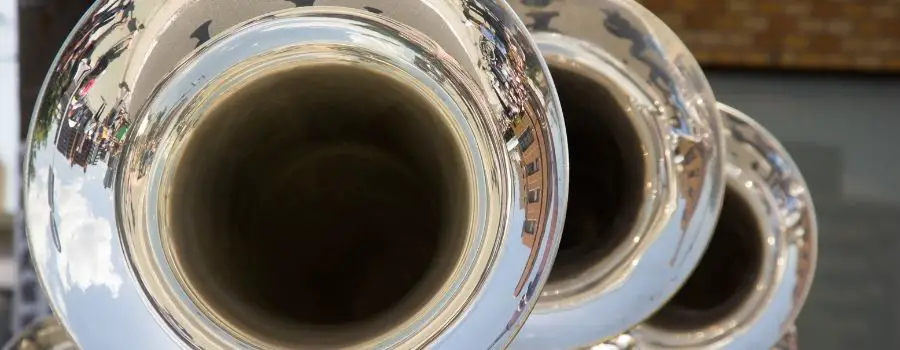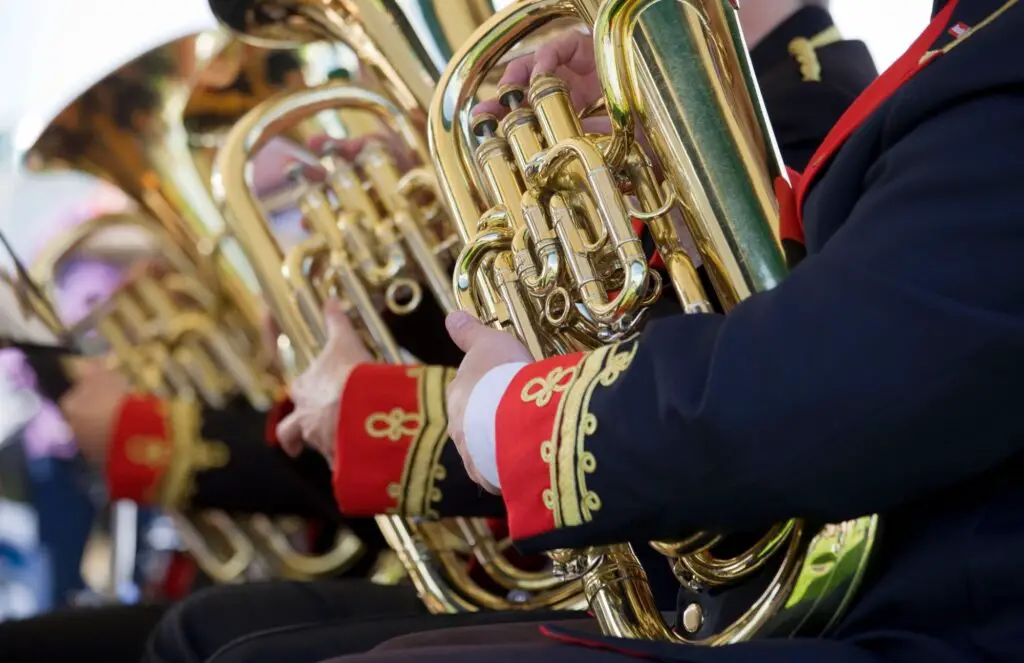
Most of us know that each instrument within a section can vary in key and/or size…there are flutes, but there are also piccolo’s, etc. But there are also some other, more subtle differences that people who don’t play a particular instrument may not know. For instance, there are euphoniums (and other brass instruments) that have a built in compensation function…let me explain.
What Is A Compensating Euphonium?
A compensating euphonium adds extra tubing to compensate for the instrument’s tendency to have a sharp low register. When the fourth valve is pressed, air is directed through an auxiliary set of slides on valves 1 through 3 this lowers their pitch, therefore becoming more in tune.
Non-compensating euphoniums can still have a fourth valve that functions similarly to the other three. In this case, the pitch is lowered 2-1/2 steps, and the player must make necessary tuning changes to bring the low range in tune.
Do Compensating And Non-Compensating Euphoniums Have The Same Range?
Whether a euphonium is compensating or non-compensating, it will have the same range. Both types of euphoniums have professionals that can comfortably play from pedal F to a high C, two octaves above middle C.
The exception to this is if the euphonium has an extra, “fifth” valve. These euphoniums have a larger bell and bore than standard euphoniums, which allows for a lower range. These are not very common, but some companies will custom make them this way if a player wants extended range or to match some tuba fingerings.
The thing with brass instruments is that there are always exceptions to range. Some players can extend the pedal note downward or play in the extreme high range of the instrument. They achieve this with a combination of practice, mouthpiece size, and other tricks they pick up along the way.

When Is A Compensating Euphonium Used?
Generally, most players at the high school and college level will have a compensating euphonium since it is considered a more professional level instrument. In some cases, a euphonium player may choose to have a non-compensating euphonium for personal preference, but it is less common.
There aren’t too many specific ensembles that would only feature a compensating…or non-compensating…euphonium. Basically, any group that would include a euphonium section will likely have players that are using compensating models.
Do All Compensating Euphoniums Have 4 Valves?
Not all compensating euphoniums have 4 valves, but most do. The fourth valve is what allows for the extra tubing to be added, which in turn creates the compensating function.
Some euphoniums only have three valves, and these are typically non-compensating models, thought that’s not always the case. These euphoniums can still create a wide range of sounds, it will just be more difficult to achieve some of the low notes.
What’s The Difference Between A Compensating And Non-Compensating Euphonium?
In general, the main difference between compensating and non-compensating euphoniums is that compensating euphoniums have an extra set of tubing that helps to make the low range more in tune.
Non-compensating euphoniums don’t have this extra tubing, which means that the player will have to make more adjustments to play in tune.
In many cases, a compensating euphonium will have four valves rather than three…but not in every case.
Are Compensating And Non-Compensating Euphoniums In The Same Key?
Both compensating and non-compensating euphoniums are in the key of Bb. But similarly to the tuba, their music is typically written in concert pitch, which means that the euphonium will sound an octave lower than what is written.
So if you see euphonium music that is in the key of C, it will actually be sounding in Bb. This nuance was born from a mix of European brass bands, which use instruments that are in either Bb or Eb. It also stems from it’s early adoption into orchestra repertoire where it wouldn’t always have a dedicated player, but rather be played by a trombonist.
European Brass Bands
Because music was writing in different keys, it made sense to standardize so that everyone could read music in the same or comparable keys, and choosing two keys enabled for more design and pitch options.
Orchestral Integration
Gustav Holst is likely the most famous composer to implement the euphonium (called a tenor tuba at that point) into his music…a little tune called, “The Planets.”
In these early days there weren’t too many dedicated orchestral euphonium players, so performance duties generally fell to a trombone player. C bass clef orchestral trombone parts are written at pitch, and it made sense to do the same for the euphonium.
How Do You Know If A Euphonium Is Compensating?
The best way to know if a euphonium is compensating or not is simply to ask the manufacturer. In most cases, they will be able to tell you definitively. Of course, as you learn more about the instrument, you’ll be able to pick up on the clues just by looking.
You can never go wrong…well, almost never…with asking the manufacturer or dealer, but if you aren’t able to talk to an expert here are some other ways to tell:
- Number of Valves – As I mentioned before, euphoniums that have four valves are generally compensating models.
- Valve Location – On a compensating euphonium, the fourth valve is usually located in line with the other three valves, while on a non-compensating euphonium, the fourth valve will be offset.
- Tubing – If you look at the euphonium and see a set of tubing that goes from the third valve to the bell, chances are it’s a compensating euphonium.
- Labeling – Some…but not all…euphoniums may have the word “compensating” stamped somewhere on the instrument.
